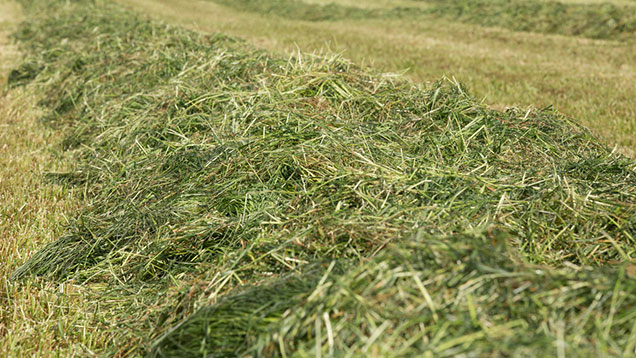Livestock 2015: Bumper silage quality predicted for dairy farmers
 © Tim Scrivener
© Tim Scrivener Dairy farmers should expect a better quality first-cut silage compared to last year, according to early analysis results.
Early first cut analysis of 1,072 silage samples from Trouw Nutrition showed quality is up on the year with average values of 68.3% D, 10.9MJ/kg of ME and 46.8% NDF, compared with the first cut in 2014 at 66.9% D, 10.7MJ/kg ME and 48.3% NDF.
Although silage results have been variable, 47% of silages analysed at more than 11ME, compared with just 21% last year, explained Trouw Nutrition ruminant manager Adam Clay at last week’s Livestock Event.
Mr Clay believed farmers could expect more milk from forage due to high potential dry matter intakes.
“Only 23% of forages are less than 10.5ME compared to 54% last year. This suggests more farmers will have better-quality feed.
“The results should equate to a minimum of 0.4 litre additional milk yield a cow a day, based on DM intakes of 10kg,” he said.
In addition to a better average nutrition analysis, Mr Clay said intake potential had also increased.
“This means cows will be more enthusiastic about eating larger quantities of silage, which will be good for diet formulation,” he added.
Key results
|
Why |
What this means for farmers |
|
|
Increased dry matter (30.2%) |
More consistent dry warm weather during first cut. |
Can allow more structural fibre which creates a stronger rumen matt, improving overall rumen health. |
|
Increased crude protein (14.2%) |
Removing oxygen from the clamp more quickly completes the fermentation process faster. This stops the breakdown of protein sooner preserving more of it. |
Good clamp stability and a stable pH of 3.9 should minimise clamp losses and mycotoxins. |
|
Increased digestibility (68.3%) |
Cold winter and sporadic frosts in April and May meant lower soil temperatures slowed grass growth and the crop was young and leafy at harvest. |
More of the crop is available for digestion. |
|
Increased energy (10.9MJ/kg ME) |
Young leafy crop with high digestibility means more energy per unit of DM. |
Increased milk yields. |
|
Increased sugars (3.5%) |
Younger crop and plenty sunlight triggers photosynthesis bringing sugars up into the leaves. |
More rapidly fermenting carbs may drive milk yields but also reduce rumen pH. |
|
Decreased fibre (46.8% NDF) |
Less stem and structure at harvest due to slower grass growth and lower covers. |
Fewer fibre-digesting bacteria lower acetic acid production, decreasing butterfats. The low-fibre element may also increase rumen pH drop. |
|
Increased intake potential (99g/kg0.75) |
Younger crop, lower fibre and high digestibility. |
Increased milk yield from forage potential and possibly total DM intakes helping to reduce feed costs. |
Balancing silage
If farmers have increased rapidly fermenting carbs with high sugars and low NDF, Mr Clay’s advice was to choose a complementary feed other than rolled wheat or barley.
“Treated wheat or barley (crimped or caustic) buffers the carbs, reduces rumen fermentation and increases use in the hind gut.”
He said maize was another alternative, with less rapidly fermenting carbs, more slowly fermenting carbs and higher bypass starch, taking pressure off the rumen.
If these are not an option, a digestible source of fibre, such as soya hulls, should be added to the diet, he said.
“Sugar beet pulp has higher rapidly fermenting carbs than soya, but is good for rumen health as it’s higher in fibre.”
Second cut
Mr Clay believed second-cut silage should also be good quality, with the shorter first cut stimulating higher growth.
However, he warned farmers not to delay second cut to try to fill the clamp up, but to go for more smaller cuts throughout the season.
“This may mean an increase in contractor charges, but it will also increase the silage quality, DM intake and energy density.”
Read more news from the Livestock Event 2015
